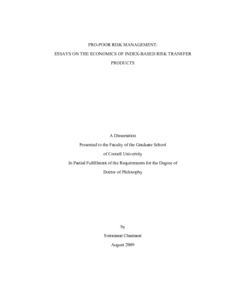Resource information
This dissertation explores innovations in index-based risk transfer products (IBRTPs)
as a means to address an important isurance market failure that leaves many poor and
vulnerable populations exposed to onsiderable uninsured risk. IBRTPs can address problems of covariate risk, asymmetric information and high transaction costs that have precluded the emergence of formal insurance market in low-income areas, where uninsured risk remains a leading cause of persistent poverty. A brief introductory chapter situates this dissertation in the broader, emergent literature on IBRTPs. The second chapter explains how the strong relation between widespread human suffering and weather shocks creates an opportunity to develop famine indexed weather derivatives to finance improved emergency response to humanitarian crises. The third chapter explains how these instruments might be designed and used by operational agencies for famine prevention in response to slow-onset disasters. It uses household data to develop a famine index based on child anthropometric data that is strongly related to rainfall variability and other exogenous measures that are reliably available at low cost; that index can be used to trigger payments to improve the timeliness and cost-effectiveness of humanitarian response. The fourth chapter develops commercially viable index based livestock insurance (IBLI) to protect livestock assets for northern Kenyan pastoralists. The underlying herd mortality index is constructed off a statistical model that relates longitudinal household-level herd mortality data to remotely sensed vegetation index data. The resulting index performs well out of sample. Pricing and risk exposure analysis also demonstrate the commercial potential of the product, which has been taken up by financial institutions in Kenya for marketing in early 2010. The fifth chapter explores the household-level performance of IBLI. It uses
simulations parameterized based on household panel data, risk preference estimates elicited in field experiments and remote sensing vegetation data to explore how well IBLI performs in preserving household wealth in this setting characterized by bifurcated livestock growth dynamics characteristic of poverty traps. Willingness to pay and aggregate demand for the contract are also estimated. This analysis shows that bifurcation in livestock herd dynamics leads to nonlinear insurance valuation regardless of risk preferences.



